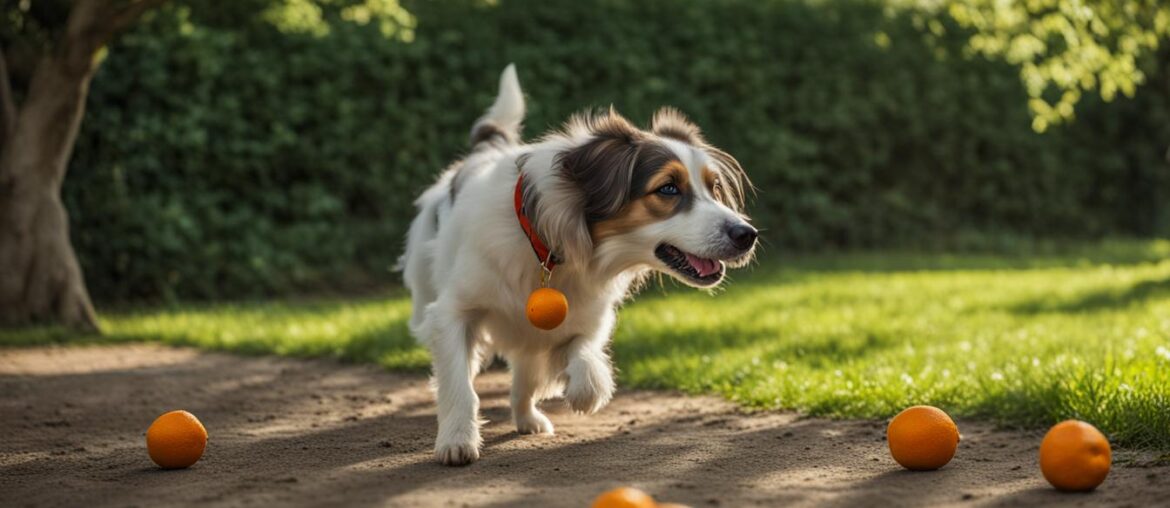When it comes to the world of color, humans have always been intrigued by how animals perceive it. One common question many dog owners have is whether dogs can see the color orange. The truth is, dogs do see colors, but their vision is different from ours.
Dogs have dichromatic vision, meaning they have two types of cones in their eyes compared to our three types. This difference in cone types affects their color perception and range. While humans see a spectrum of colors from red to violet, dogs’ color range is limited.
So, can dogs see orange? Yes, dogs can see orange, but not as vividly as humans do. Dogs perceive orange as a shade of yellow or brown. To them, the color orange may appear muted or less vibrant.
Understanding a dog’s color vision is crucial in providing them with toys and objects that they can see and interact with effectively. In the next sections, we will explore more about how dogs see colors, their visual perception, and how this knowledge can enhance their daily experiences.
Key Takeaways:
- Dogs have dichromatic vision, meaning they see colors differently from humans.
- Dogs can see orange, but it appears as a shade of yellow or brown to them.
- Choosing toys and objects in colors that dogs can easily distinguish can enhance their interaction with their surroundings.
- Dogs’ color vision is more similar to that of humans with red-green colorblindness.
- Understanding dogs’ limited color perception can help enhance their playtime and overall well-being.
Signs Dogs Can See Colors
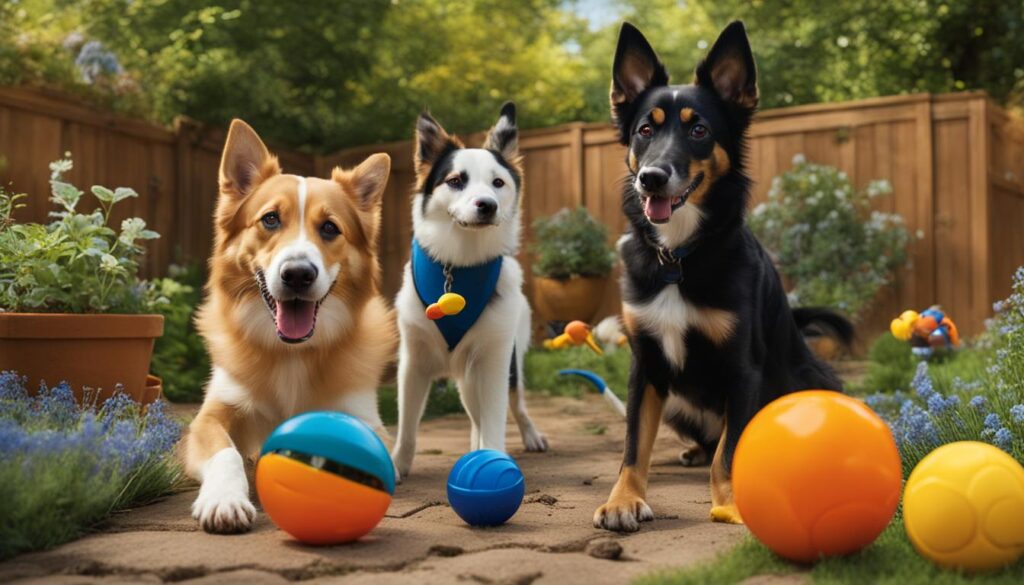
While dogs may not be able to see the full spectrum of colors like humans, they do have the ability to perceive certain shades. Studies have shown that dogs are capable of seeing shades of blue and yellow. This limited color vision can have noticeable effects on their behavior and preferences.
One sign that dogs can see colors is their preference for toys that are blue or yellow. Dogs tend to be more attracted to toys in these colors and may show increased interest and enthusiasm when playing with them. This preference suggests that they can distinguish between different hues and are visually drawn to certain colors.
Furthermore, dogs may exhibit specific behaviors when they encounter blue or yellow objects. They may display heightened alertness, barking, head tilting, wagging tail, and raised ears in response to these colors. These reactions indicate that dogs are aware of the presence of blue and yellow objects and perceive them as distinct from their surroundings.
It’s important to note that dogs may have difficulty finding toys in the grass if they are not blue or yellow. This is because green, which is the color of grass, appears faded or muted to dogs due to their limited color perception. By providing toys in colors that dogs can easily see, such as blue and yellow, owners can enhance their dogs’ playtime and ensure that they can find and interact with their toys effectively.
| Signs that Dogs Can See Colors |
|---|
| Favoring toys that are blue or yellow |
| Displaying alertness, barking, head tilting, wagging tail, and raised ears in response to blue or yellow objects |
| Difficulty finding toys in the grass if they are not blue or yellow |
History of Dogs Being Able to See Colors
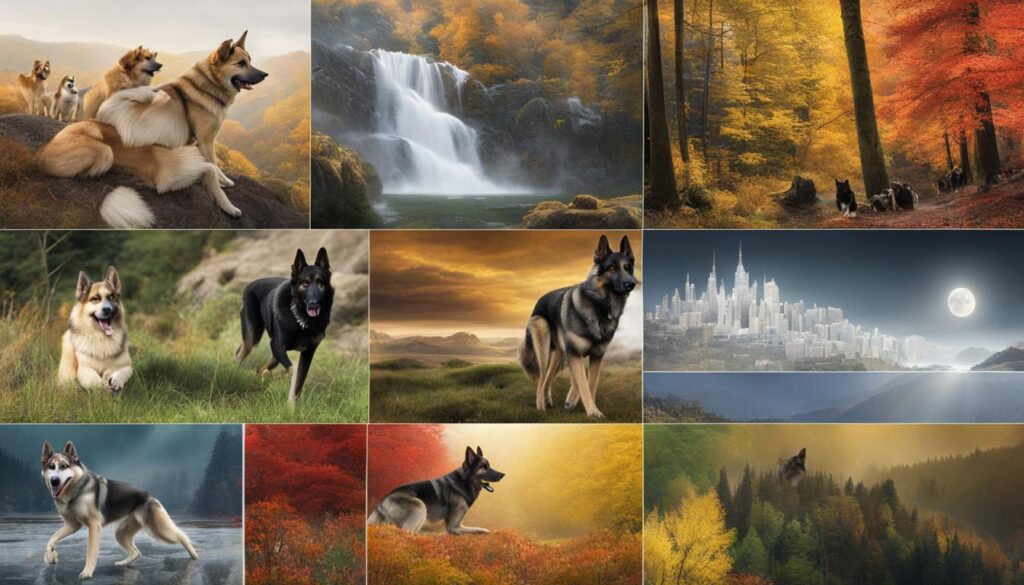
For many years, the prevailing belief was that dogs were completely colorblind. It was thought that their world consisted only of shades of black, white, and gray. However, research conducted in the 2010s debunked this myth and revealed that dogs do have the ability to see colors, albeit in a limited range.
In the 1930s and 1960s, researchers made claims about dogs’ poor vision and their inability to perceive colors. These theories were widely accepted at the time and reinforced the notion that dogs lacked the ability to see the vibrant hues that humans can. However, as scientific understanding evolved and more comprehensive studies were conducted, it became evident that dogs do have some capacity for color vision.
With advancements in technology and research methods, scientists were able to uncover key insights into dogs’ visual perception. It was discovered that dogs have two types of color-detecting cells, or cones, in their retinas. These cones are responsible for allowing dogs to perceive certain colors, albeit in a more limited way compared to humans with trichromatic vision.
Ken Thompson, Canine Vision Expert:
“The belief that dogs are colorblind was widely perpetuated for many years. It was not until recent research that we were able to conclusively prove that dogs do have some degree of color vision. This has significantly changed our understanding of how dogs perceive the world around them.”
While dogs may not see colors with the same vibrancy and range as humans, they can still differentiate between certain shades. Dogs have a higher sensitivity to blues and yellows, which are more easily distinguishable to them. In contrast, colors such as red, green, and orange appear as various shades of gray or brown to dogs.
This limited color perception in dogs is attributed to their biological makeup, specifically the composition of their retinas. Dogs have a higher number of rods, which enable them to see better in low light conditions, but fewer cones that are responsible for color perception. This difference in cone ratios is what accounts for their narrower color spectrum compared to humans.
Understanding the history of dogs’ ability to see colors helps us appreciate their unique visual perception. While they may not experience the same vibrant world of colors that we do, they still have the capacity to distinguish and respond to specific hues. This knowledge can guide us in choosing objects and toys that are more visually stimulating for our beloved canine companions.
Science Behind Dogs Being Unable to See Orange
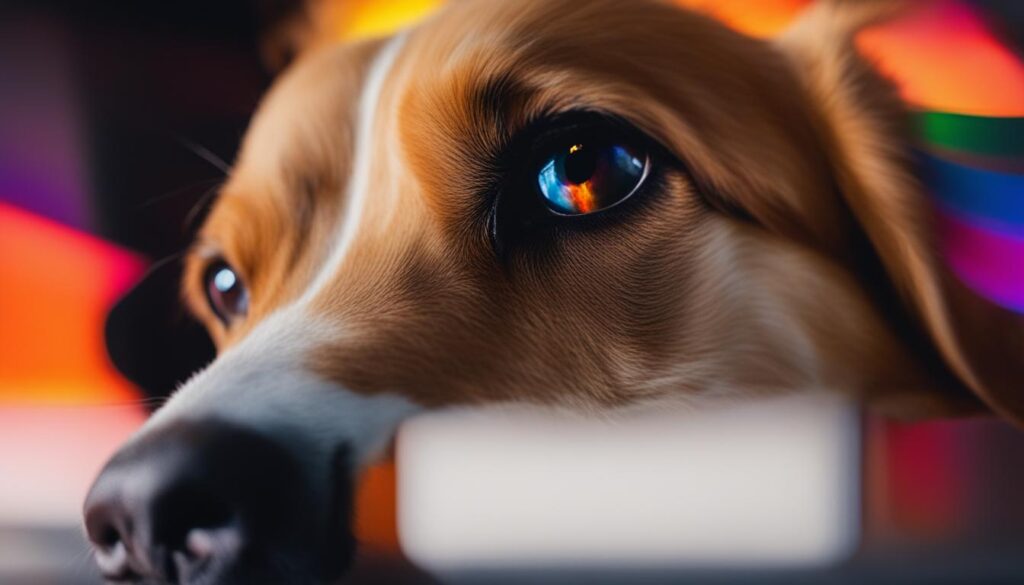
The biology of dogs’ eyes plays a significant role in their limited color perception, including their inability to see the color orange. Unlike humans, dogs have more rods than cones in their retinas, which affects their visual capabilities. Rods are responsible for low-light vision, enabling dogs to see better in dim environments, but they do not contribute to color perception.
In terms of cones, dogs have fewer cones compared to humans, leading to a narrower range of color vision. Specifically, dogs have a reduced number of cones responsible for perceiving red and green colors. This similarity to humans with red-green color blindness means that dogs lack the ability to distinguish between certain shades of red, green, and orange.
While the exact reason behind dogs’ inability to see the color orange is not fully understood, it is believed to be a combination of their biology and evolution. Dogs’ visual systems have evolved to prioritize other aspects of their environment, such as motion and scent, rather than accurate color discrimination.
Comparing Humans and Dogs: Cones and Color Perception
To get a better understanding of the difference in color perception between humans and dogs, let’s compare their cone types:
| Humans | Dogs | |
|---|---|---|
| Cones for Red Perception | Present | Reduced |
| Cones for Green Perception | Present | Reduced |
| Cones for Blue Perception | Present | Present |
In this table, we can see that dogs have a reduced number of cones for perceiving both red and green colors, whereas humans have fully functional cones for all three primary colors. This difference in cone distribution contributes to dogs’ limited color vision and their inability to see distinct shades of orange.
Understanding the science behind dogs’ inability to see orange allows us to tailor their environment and interactions to better suit their visual capabilities. By choosing toys, objects, and training aids in colors dogs can perceive more vividly, such as blue and yellow, we can enhance their experiences and ensure a more enriching and colorful world for our canine companions.
Dealing With Dogs Seeing Color

To cater to a dog’s vision, it is important to choose toys and objects in colors that they can see vividly, such as blue and yellow. Dogs have a limited color perception, and certain colors may appear dull or blend in with their surroundings. Understanding your dog’s unique visual abilities can help enhance their playtime and overall experience.
When selecting toys for your dog, opt for colors that stand out to them, like blue or yellow. These colors are within their color spectrum and can be easily distinguished. Avoid getting toys in colors such as green or orange for play in the grass, as these colors may appear dull or blend with the natural environment.
By choosing toys in colors that dogs can see vividly, you can ensure their engagement and enjoyment during playtime. Providing them with toys that contrast with their surroundings will make it easier for them to locate and interact with the toys.
Enhancing Playtime with Colorful Toys
Colors play an important role in a dog’s visual perception. By incorporating blue and yellow toys into their play routine, you can enhance their overall experience.
- Choose toys in vibrant shades of blue and yellow.
- Select toys with contrasting colors to their surroundings.
- Consider the size and texture of the toys for added stimulation.
- Rotate toys regularly to keep their interest and prevent boredom.
- Supervise playtime to ensure the toys are safe and in good condition.
Remember, dogs rely on other senses like smell and hearing more than vision. While color choices for toys can enhance their playtime, it’s essential to provide a stimulating and enriching environment that caters to all their senses.
| Color | Perception by Dogs |
|---|---|
| Blue | Visible and distinguishable |
| Yellow | Visible and distinguishable |
| Green | May appear dull or blend in with surroundings |
| Orange | May appear dull or blend in with surroundings |
Understanding your dog’s limited color perception and tailoring their environment to their needs can enhance their overall well-being and happiness. By choosing toys and objects in colors that they can see vividly, you can provide them with a stimulating and enjoyable experience during playtime.
The Notion of Dogs Being Color Blind
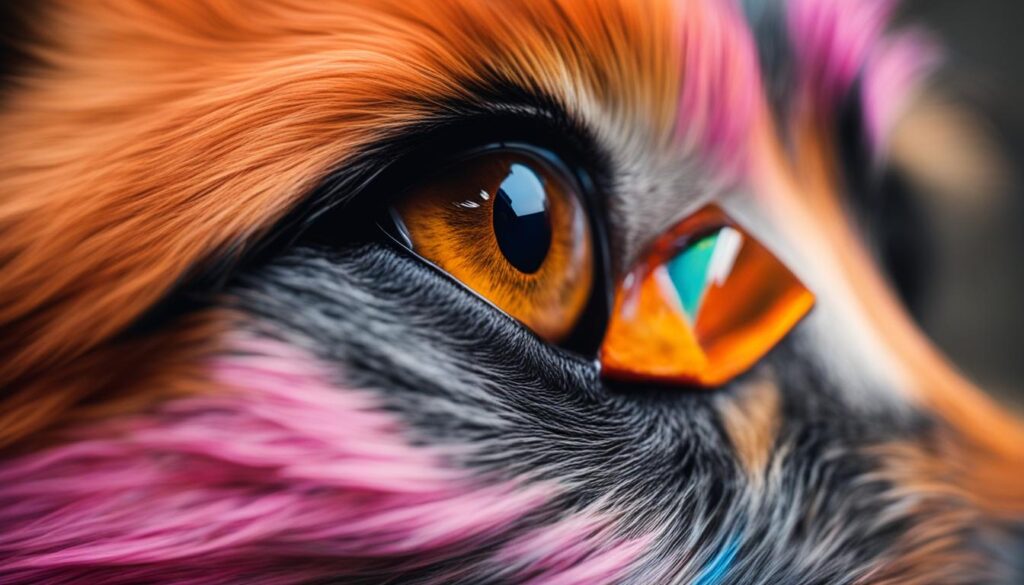
The belief that dogs are color blind has been a long-standing misconception. It was widely accepted that dogs could only perceive the world in shades of black and white. However, thanks to ongoing research and advancements in our understanding of canine vision, we now know that this notion is far from the truth.
Contrary to popular belief, dogs do have some ability to see colors, although their range of color perception is limited compared to humans. While they may not see the full spectrum of colors that we do, they are not completely color blind either.
Early studies in the 20th century suggested that dogs were unable to see colors and had monochromatic vision. However, more recent research has revealed that dogs have dichromatic vision, meaning they can perceive certain colors, albeit in a different way than humans.
Like humans, dogs have specialized cells in their eyes called cones, which are responsible for color vision. However, while humans have three types of cones that detect red, green, and blue light, dogs have only two types of cones. This means that dogs lack the ability to perceive the colors red and green, which are a significant part of the human color spectrum.
Instead, dogs primarily see the world in shades of blue and yellow. These colors stand out more to them and appear more vibrant compared to other colors. This is why many dog toys are designed in blue or yellow to cater to their visual preferences.
It’s important to note that while dogs may not see the same range of colors as humans, they compensate for this with their exceptional sense of smell and keen hearing. Dogs rely on these senses to gather information about their environment and navigate the world around them.
So, while dogs are not color blind in the traditional sense, their color perception is different from ours. Understanding their unique visual abilities can help us provide an environment that is visually stimulating and engaging for our canine companions.
How Dogs See Colors
Dogs have dichromatic vision, meaning they have two types of cones compared to humans’ trichromatic vision with three types of cones. Dogs can see yellow and blue, which gives them a limited color spectrum. They perceive the world in shades of blue, yellow, and gray, with colors like red, green, and orange missing.
Can Dogs See Colors Like We Can?

Scientists have conducted extensive research to understand how dogs perceive colors. While dogs have the ability to see colors, their visual spectrum is different from humans. In fact, scientists have concluded that a dog’s color vision is similar to that of a human with red-green color blindness.
Dogs can perceive colors on a limited scale, primarily yellow and blue. However, unlike humans who see a vibrant array of colors, dogs see the world in a more grayish-brown tone. Their color vision lacks the ability to distinguish between red, green, and orange shades.
To enhance a dog’s interaction with their surroundings, it is important to consider their limited color perception. By choosing toys, objects, and accessories in colors that dogs can easily distinguish, such as yellow and blue, dog owners can ensure a more engaging and enjoyable experience for their furry companions.
Understanding how dogs perceive colors is crucial in providing them with a stimulating environment. By adapting to their unique color vision, pet owners can create enriching experiences that cater to their four-legged friends’ needs and preferences.
| Color | Dog’s Perception |
|---|---|
| Yellow | Perceived, but may appear more dull or muted compared to humans |
| Blue | Perceived, but may appear as a grayish-blue |
| Red | Difficult to distinguish, may appear as a shade of gray or brown |
| Green | Difficult to distinguish, may appear as a shade of gray or brown |
| Orange | Difficult to distinguish, may appear as a shade of gray or brown |
Wrapping Up
Dogs have the fascinating ability to see some colors, although their range is limited compared to humans. While it was once believed that dogs were completely colorblind, research has shown that they have a unique color perception. Understanding this can greatly benefit dog owners in providing a more enriched environment for their furry companions.
By selecting toys and objects in colors that dogs can easily distinguish, such as blue and yellow, owners can enhance their pets’ playtime and overall well-being. For example, dogs tend to have a preference for toys that are blue or yellow, and having these colors in their playthings can make their interactions more enjoyable.
It is important to recognize that dogs perceive the world in shades of blue, yellow, and gray, with colors like red, green, and orange appearing dull or even invisible to them. With this knowledge, we can make informed choices to keep our dogs engaged and content. By catering to their limited color vision, we can create a more vibrant and exciting environment for our beloved pets, ensuring they are living their best lives.
FAQ
Can dogs see orange?
Dogs have limited color perception and see the world in shades of blue, yellow, and gray. They cannot see colors like red, green, or orange as vividly as humans can.
What signs indicate that dogs can see colors?
Dogs may display signs of alertness, such as barking, head tilting, wagging tail, and raised ears, when they see objects in colors they can perceive, like blue or yellow.
What is the history of dogs being able to see colors?
The myth that dogs are colorblind persisted for many years until research in the 2010s proved otherwise. In the past, it was believed that dogs could only see in shades of black and white.
What is the science behind dogs being unable to see orange?
Dogs have dichromatic vision, meaning they have two types of cones in their eyes compared to humans’ trichromatic vision with three types of cones. Dogs lack the specific cones responsible for perceiving red and green colors, making it difficult for them to see colors like orange.
How can I deal with my dog’s color vision?
To cater to a dog’s color vision, choose toys, and objects in colors that they can see vividly, such as blue and yellow. Avoid using green or orange toys in grassy environments, as they may appear dull or blend in with the surroundings.
What is the notion of dogs being color blind?
The notion that dogs are colorblind originated from the belief that they could only see in shades of black and white. However, research and advancements in understanding canine vision have proven that dogs can perceive certain colors, although their range is limited.
How do dogs see colors?
Dogs have dichromatic vision, allowing them to see colors like blue and yellow. They perceive the world in shades of blue, yellow, and gray, with colors like red, green, and orange appearing more muted or grayish.
Can dogs see colors like we can?
Dogs have a different color perception compared to humans with trichromatic vision. While they can perceive some colors, their range is more limited, similar to humans with red-green color blindness.
What is the conclusion about dogs’ color vision?
Dogs have a biologically different perception of colors compared to humans. They can see in a limited color range, with a preference for shades of blue and yellow. Understanding a dog’s limited color perception can help enhance their playtime and overall experience.


